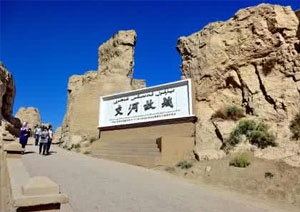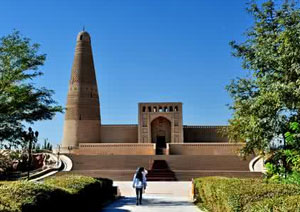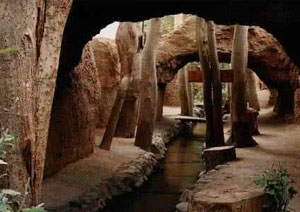
 The Ancient Gaochang City is located about 40 kilometers east to Turban City in the Xinjiang Autonomous Region. In 1961, the Ancient City of Gaochang was publicized as one of the key national cultural relics protection unit by the State Council. The Ancient City of Gaochang consists of the outer city, the inner city and the palace city. The city was first built in the Han Dynasty (206BC-220AD) and then named Gaochangbi. Having passed through the Han, Wei, and Jin dynasties, the city experienced several phases, including Gaochang Prefecture, Gaochang Capital, Gaochang County, Gaochang Huihu State, till its desolation in the late Yuan and early Ming, lasting over 1,400 years.
The Ancient Gaochang City is located about 40 kilometers east to Turban City in the Xinjiang Autonomous Region. In 1961, the Ancient City of Gaochang was publicized as one of the key national cultural relics protection unit by the State Council. The Ancient City of Gaochang consists of the outer city, the inner city and the palace city. The city was first built in the Han Dynasty (206BC-220AD) and then named Gaochangbi. Having passed through the Han, Wei, and Jin dynasties, the city experienced several phases, including Gaochang Prefecture, Gaochang Capital, Gaochang County, Gaochang Huihu State, till its desolation in the late Yuan and early Ming, lasting over 1,400 years.
 The Ancient City of Jiaohe is one of the world's architectural wonders hiding in the Yarnaz Valley, 10 kilometers west of Turpan City. Shaped like a willow leaf, the ancient city of Jiaohe has a history of 2,300 years and lies between two rivers on a loess plateau atop a cliff of over 30 meters. Jiaohe is 1,760 meters long from northwest to southeast and is 300 meters at its widest, with an area of 430,000 square meters. In the Western Han Dynasty (206BC - AD24), the city served as the capital of the Ancient State of Cheshi, one of the 36 kingdoms in the Western Regions.
The Ancient City of Jiaohe is one of the world's architectural wonders hiding in the Yarnaz Valley, 10 kilometers west of Turpan City. Shaped like a willow leaf, the ancient city of Jiaohe has a history of 2,300 years and lies between two rivers on a loess plateau atop a cliff of over 30 meters. Jiaohe is 1,760 meters long from northwest to southeast and is 300 meters at its widest, with an area of 430,000 square meters. In the Western Han Dynasty (206BC - AD24), the city served as the capital of the Ancient State of Cheshi, one of the 36 kingdoms in the Western Regions.
 Two kilometers east of the Silk Road town of Turfan stands the Emin Mosque with its monumental minaret, the tallest in China. Also known as Sugong Tower (Sugong Ta), the minaret was built in a simple Islamic style. It is circular, 44 meters in height, and 10 meters in diameter at the base. Unfortunately, the minaret is no longer open to the public in an effort to preserve the structure, however, you can view the surroundings from the roof of the mosque. The mosque was built in 1779 during the Qing Dynasty in memory of the Uygur King Emin Khoja by his son King Suleiman. The large fortified mosque, raised on a platform, stands alone outside the city, devoid of any auxiliary buildings.
Two kilometers east of the Silk Road town of Turfan stands the Emin Mosque with its monumental minaret, the tallest in China. Also known as Sugong Tower (Sugong Ta), the minaret was built in a simple Islamic style. It is circular, 44 meters in height, and 10 meters in diameter at the base. Unfortunately, the minaret is no longer open to the public in an effort to preserve the structure, however, you can view the surroundings from the roof of the mosque. The mosque was built in 1779 during the Qing Dynasty in memory of the Uygur King Emin Khoja by his son King Suleiman. The large fortified mosque, raised on a platform, stands alone outside the city, devoid of any auxiliary buildings.
 Karez Well is a kind of underground water works invented and built by laboring people of various ethnic groups in our country to adapt to the natural environment in dry region. The history of the karez, mainly used in the Hami and Turpan areas in Xinjiang, where it is hot and dry, dates back to the Han Dynasty (206 B.C. - 220 A.D.). It is considered one of the three great projects in ancient China, along with the Great Wall and the Beijing-Hangzhou Grand Canal. Why Karez Wells were built in great number in Turpan Basin can be attributed to the local natural geographical conditions. To the north of Turpan Basin is Bogda Mountain and to its west Kalawucheng Mountain.
Karez Well is a kind of underground water works invented and built by laboring people of various ethnic groups in our country to adapt to the natural environment in dry region. The history of the karez, mainly used in the Hami and Turpan areas in Xinjiang, where it is hot and dry, dates back to the Han Dynasty (206 B.C. - 220 A.D.). It is considered one of the three great projects in ancient China, along with the Great Wall and the Beijing-Hangzhou Grand Canal. Why Karez Wells were built in great number in Turpan Basin can be attributed to the local natural geographical conditions. To the north of Turpan Basin is Bogda Mountain and to its west Kalawucheng Mountain.
| Turpan Attractions List | |

